Nintendo Wii U Teardown
by Anand Lal Shimpi on November 18, 2012 8:07 PM ESTWhen Nintendo announced the Wii U there was a lot of interest in its hardware specs. The new console could very well end up the fastest kid on the block thanks to the sheer age of the Xbox 360 and PlayStation 3. I wasn't all that interested in the Wii U, but I did want to get a look at the silicon inside so I grabbed a unit and went into teardown mode.
The Wii U is available in two versions: the basic and deluxe kits. The basic kit comes in white, while the deluxe is black. Both are glossy. The deluxe console gives you 32GB of on-board storage (eMMC NAND) vs. 8GB for the standard model. The deluxe kit also includes a stand and cradle for the Wii U tablet GamePad as well as a stand for the console itself. The two kits retail for $299.99 and $349.99, respectively.
The Wii U hardware itself looks a lot like a larger Wii. Getting inside the chassis is also quite similar. The CMOS battery door is the first thing you'll have to remove, followed by 8 more screws (a mixture of philips head and tri-wing). The bulk of these screws are behind console-colored stickers, be sure to peel them all off. With all 8 (9 including the CMOS battery door) screws removed, you can slide the left side of the Wii U away from the front of the console, and off all together. This reveals the final three tri-wing screws that you'll need to remove to get inside the chassis (the gallery of all of this is at the bottom of the article).
With all 12 screws removed, pry the top of the Wii U up and away from the body until it separates from the rest of the frame revealing the console's fairly compact internals:
The Wii U optical drive uses a custom format for game storage, but offers a very Blu-ray-like 25GB capacity per disc. Max sequential read speeds are pretty high compared to the current gen consoles at 22MB/s.
Two screws hold the front cover in place, followed by four screws that hold the optical drive in place. Be careful when removing the optical drive as there's a ribbon cable attached to the motherboard for power/data. The same goes for the front cover, although its ribbon cable is really only on light/switch duty.
With the optical drive removed, next up is removing the shielding on the top and bottom of the motherboard and the shround on top of the heatsink. Just go around the perimeter of the motherboard removing screws (you'll be able to remove all but two easily). Once you've done this, the motherboard will be able to separate from the Wii U's lower tray.
Removing the shielding itself requires carefully moving the antenna cables out of the way. As these wires are soldered to the Wii U chassis on one end, be very careful not to pull too hard otherwise you run the risk of needing to break out the soldering iron.
If you've removed all of the screws and freed the antenna wires from their guides a bit, you should be able to pull back the plastic heatsink shroud, revealing...more shielding:
With no screws left to hold it in place however, the shielding is easily dealt with (again pay close attention to the antenna wires). The same is true for the bottom of the PCB.
The two sets of antenna wires go to two independent wireless controllers: one for 802.11b/g/n WiFi, the other to a dedicated 802.11n controller to handle Miracast display streaming between the Wii U and the GamePad display. Thanks to Ryan Shrout over at PC Per for figuring this one out!
Once you've removed all shielding you're left with a pretty clean looking motherboard:
On the top side of the board you'll see the eMMC/NAND package, in this case it's a dual-die Samsung eMMC solution (there's another Toshiba NAND device on the back of the board, not for user storage):
There are four 4Gb (512MB) Hynix DDR3-1600 devices surrounding the Wii U's MCM (Multi Chip Module). Memory is shared between the CPU and GPU, and if I'm decoding the DRAM part numbers correctly it looks like these are 16-bit devices giving the Wii U a total of 12.8GB/s of peak memory bandwidth. (Corrected from earlier, I decoded the Hynix part numbers incorrectly). Our own Ryan Smith found a great reference for the original Wii so we can compare memory frequencies. It looks like the original Wii had a 32-bit wide GDDR3 memory interface running at a max datarate of 1.4GHz for a total of 5.6GB/s of bandwidth (excluding eDRAM).
That doesn't sound like a lot (it's the same amount of memory bandwidth on the Nexus 10 and iPad 3/4), but the Wii U is supposed to have a good amount of eDRAM for both the CPU and GPU to use. Also keep in mind that the Nexus 10 and iPad 3/4 have to drive much higher resolutions than the Wii U does.
The Wii U's MCM is unfortunately covered by a heatspreader, but given that I went through all of this to look at the console's silicon, I was going to look at the console's silicon.
Normally to remove an integrated heat spreader (IHS) you grab a sharp blade and go around cutting the (hopefully) glue around the perimeter of the chip. In the case of the Wii U's MCM, the blades I'd normally use were too thick. A few years ago I decided to give shaving with a double edge safety razor a try. My attempts failed poorly, but I had a stack of unused DE razor blades that were thin enough to get the IHS off.
The trick here is to apply enough pressure to the blade to cut through the glue, as simply trying to saw through the glue will take forever. There are two blobs of glue per side, but if you're trying to remove the IHS be careful not to cut through the glue and scrape any of the actual exposed silicon...like I did.
With the IHS off, we have the Wii U's MCM in all of its glory:
There are actually three components on this single package, made in at least two different microprocessor fabs. The multicore PowerPC based CPU is the smaller of the two larger chips. This die is made on IBM's 45nm SOI process. The RV7xx derived GPU is the biggest die on the package, and I'm presuming it was made on a 40nm process. I'm assuming the very tiny die in the corner is actually some off-chip memory. Both the CPU and GPU in the Wii U are supposed to have some eDRAM, although the bulk of it is likely dedicated for the GPU.
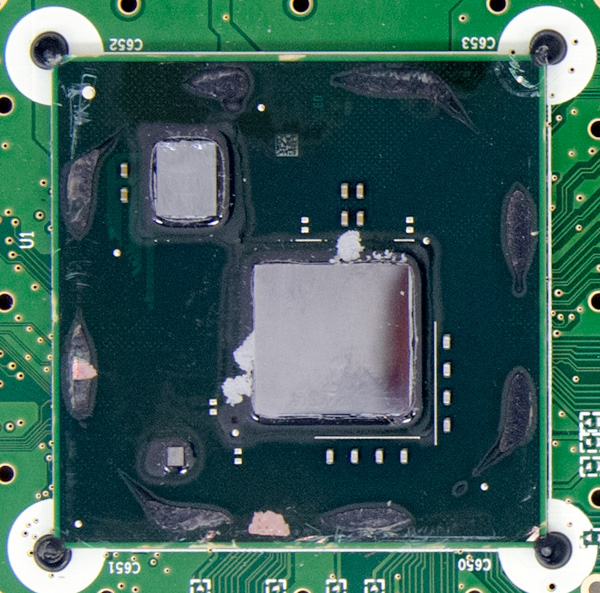
Clockwise from the top: CPU, GPU, off-chip memory?
The approximate die sizes for all components on the MCM are in the table below:
| Wii U Silicon Analysis | ||||
| Dimensions | Approximate Die Size | |||
| CPU | 5.2mm x 6.3mm | 32.76mm2 | ||
| GPU | 12.3mm x 12.7mm | 156.21mm2 | ||
| 3rd die (memory?) | 1.79mm x 1.48mm | 2.65mm2 | ||
If we assume a 40nm process for the GPU, then we're looking at something a bit larger than the RV740. The Wii U does boast backwards compatibility with games made for the original Wii, which is made possible thanks to a shared ISA with the original PowerPC based Wii.
The size comparison between CPU and GPU die shouldn't be too much of a surprise. When building a dedicated gaming machine it always makes sense to throw more transistors at your GPU. The nearly 5x ratio of GPU to CPU die size here is a bit on the extreme side though. I suspect many of the current generation consoles, including the Wii U, suffered from a lack of a powerful yet affordable CPU solution that could be easily implemented.
I also took some power measurements on the Wii U. The system is powered by a 75W external power supply, but total system power consumption doesn't even hit half of that (at least with the games I tried):
| Wii U Power Consumption | ||||
| System Power Consumption in Watts | ||||
| Standby (Power Off) | 0.22W | |||
| Wii U Menu (No Disc in Drive) | 31.2W | |||
| Wii U Menu (Disc in Drive) | 32.8W | |||
| Super Mario U | 33.0W | |||
| Netflix Playback | 28.5W | |||
Rendering the Wii U menu actually consumes almost as much power as playing Super Mario U. Watching a movie on Netflix consumes a bit less power, my guess is a lot of the 3D blocks are power gated leaving only the CPU cores and video decode hardware active.
The Wii U ships with its own web browser based on webkit, the user agent string for the latest version of the Wii U's software is: Mozilla/5.0 (Nintendo WiiU) AppleWebKit/534.52 (KHTML, like Gecko) NX/2.1.0.8.21 NintendoBrowser/1.0.0.7494.US.
Pages load quickly and compatibility is surprisingly decent (HTML5 test: 258 + 4 bonus points). By default you control and view the browser on the GamePad, but you can also choose to display the content on your TV via the console. Scrolling is very smooth and the overall experience is way better than what you'd normally expect from a web browser on what's primarily a game console. It's not quite as good as using a modern tablet, but still usable. And where there is a browser, we will run SunSpider on it:

The browser is using an older version of WebKit, which is likely responsible for some of the not absolutely stellar performance here.


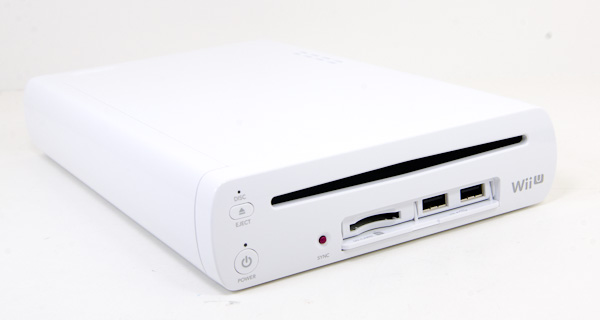

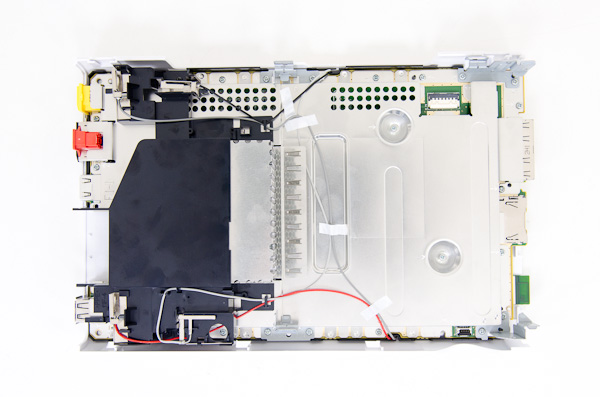
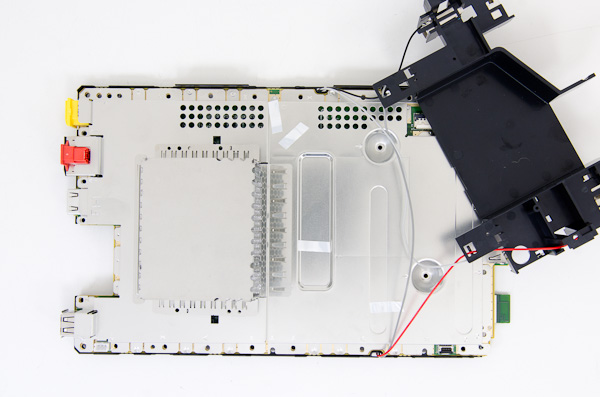
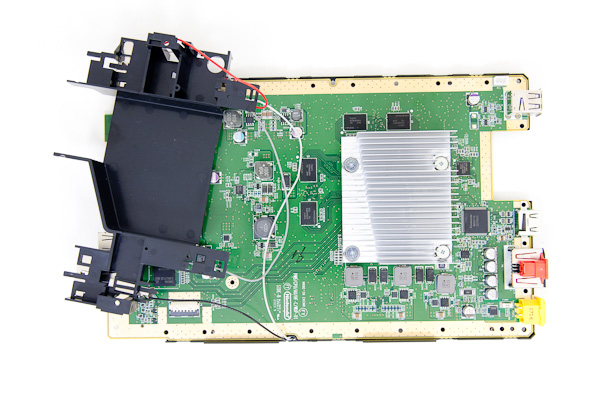
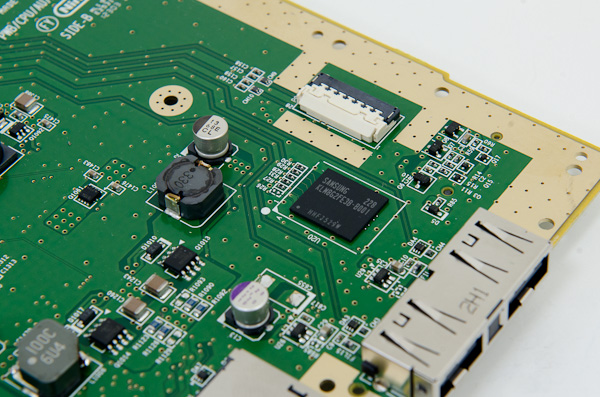

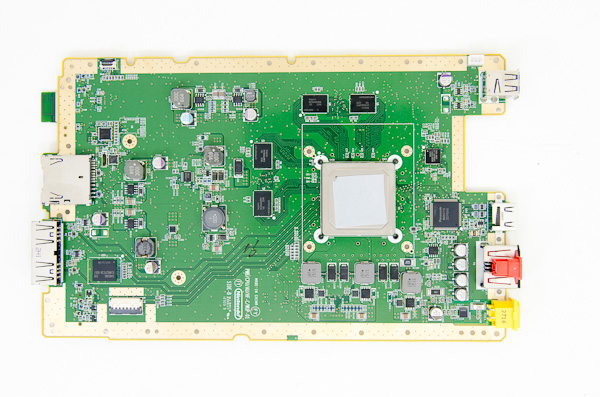















132 Comments
View All Comments
tipoo - Wednesday, November 21, 2012 - link
The Wii U CPU is about as big as a *single* core Atom at 45nm, while packing three cores. Size isn't everything, but there is only so much you can do with a certain number of transistors. If three cores is true, each core has about a third the transistor budget of one Atom core. That's crazy small. Even six years later, I don't find it likely something as big as one Atom core can do more work than the Cell or Xenon, as inefficient as those were.wiiboy101uk - Wednesday, November 21, 2012 - link
3x powerpc 400/476fp type cores with added broadw2ay fied extentions and a custom 3mb edram catchthe 3mb edram catch is thesame size and heat as a 1mb sram catch and the 3xcore powerpc 400 custom is about the same size as a broadway cpu in wii
the powerpc 476fp is 2x per clock the power of a ARM A9 and wiiu cpu is again upgraded over that core with gamecentric uogrades real time decompression data compression and graphics burst pipes/buffer AKA A NEW VERSION OF GEKKO/BROADWAY
wiiu cpu core is the most powerfull powerpc 32 bit core even made so that makes it the most powerful 32 bit risc core on earth a standard powerpc 476fp is 2x the chip of a ARM A9 at the same speed and wiiu expresso cores are a step up again
a tri core wiiu cpu at say 1.6ghz will eat a 2.0ghz arm a9 4x core for breakfast with ease
powerpc 476fp and wiiu cpu are 5 instructions per clock efficient the arm a9 is 2 instructions efficient powerpc 476fp runs on a 128 bit bus arm a9s run on a 64 bit bus arm a9s have catch issues and max 1mb sram catch
wiiu cpu has a edram catch and its 3mb its the fastest 32bit risc core on earth PROVE ME WRONG
wiiu ram is ether 64 bit x 2 or 128bit x 1 or 128bit x1 and a secondary 32 bit ram bus for os only LIKE WII AND GANECUBE DUAL BUS
wii 64bit plus 32 bit gamecube 64 bit plus 8 bit
so wiiu is ether 128 bit plus 32 bit or just 128 bit or dual 64 bit THATS COMMONSENSE
the main ram is not 32 bit LOL ana and tech
tipoo - Sunday, November 25, 2012 - link
It won't be competing with ARM cores...wiiboy101uk - Wednesday, November 21, 2012 - link
lol an and tech and all other haters you lied about gamecube vs xbox all those years ago and now your lying about wiiuso the wiiu has a 16 bit to 32 bit bus and has bandwidth in main ram of 6.4 to 12.8 GB that is complete crap an and tech....
powerpc 32 bit 400s @ 45nm have 128 bit ring bus not a 64 bit fsb like wii and gamecube also the main bus ram was 64 bit in gamecube and wii and secondary bus was 8 bit gamecube and 32 bit wii WITCH YOU ALREADY KNOW AN AND TECH
so why the anti nintenoism nonsense wiiu has 6.4gb then its 12.8gb WHEN YOU KNOW 100% GAMECUBE AND WII WERE 65 BIT BUS NOT 32 BIT LIKE YOUR NOW TRYING TO SAY
the 2gb ram is ether of the 3 set ups that follow and nothing like what your saying OUT OF NINTENDO HATE I MAY ADD
2gb 1600 ddr3 800mhz bus 128 bit = 28gb not 12.8 or 6.4 it = 28gb
so 2x 64bit = 28gb and 1 x 128 bit = 28gb SO WERE IN HELL DID YOU GET 6.4 OR 12.8 GB
the ram is likely 1600mhz 800 dual channel the bus is likely 128 bit or dual 64bit the powerpc 400 range run on a 128 bit bus at 800mhz
so the information we ALL HAVE is 1600 mhz ram 800 bus 800 gpu and 1600 cpus
so at dual 64 bit or single 128 bit the bandwidth = 28gb not 6.4 or 12.8 or 17gb
17 was a lie 6.4 was a lie and 12.8 was a lie
powerpc 45nm runs at 1600mhz with 800mhz bus
the wii and gamecube was based around the bus speed so if that continues the LOGICAL conclusion at this point =
cpu 1600 customized powerpc 400 with ibm edram catch 3mb
gpu customized rv7 4670 with 32mb edram at 800mhz
ring bus 128 bit 800 mhz
ram ddr3 or gddr3 at 800mhz dual channel = 1600mhz and 28gb bandwidth
32mb edram buffer/catch to gpu will have a massive bandwidth and the 3mb catch to cpu will be 2x plus the bandwidth of sram under the same conditions
so high bandwidth low latency like gamecube alover again
oh that xbox vs gamecube you did years ago ASLO FULL OF SHIT
weak gpu fixed function PLEASE AN AND TECH STOP LYING
xbox gpu was 4 texture layers and 8 texture stages
gc flippewr was 8 texture layers and 16 stages
xbox gpu was 8x4 real time lighting
flipper was 8x8 real time lighting
flipper had 2.5 x the internal bandwidth of xbox gpu
theres many more facts i can add
lol at you blatant anti nintendo wiiu tear down as if wiiu only has 6.4gb bandwidth or 12.8gb as wii had
28gb bandwidth edram and 4gb 1tsram and 4gb gddr3
the main ram of wii was 4gb x 2 = 8 so your saying wiiu has less bandwidth than wii or only 50% more please stop an and tech your loosing all credability
Flyingcircus - Thursday, November 22, 2012 - link
no the bit interface checks outthe model number on the chips (which you can see on the pictures, they're not made up) leads to DRAM chips by hynix with a 16 bit wide interface
just because the basic cpu-model has a wider interface that doesn't mean it's being used or even exists on the custom wii-u cpu, besides wider interfaces require more space on the die and as you can see space is already pretty rare
dual channel mode only works if there's actually any capacity left to run it with.. if you have a PC with 2 DRAM modules for example.. each module will have a bandwidth of 64 bits.. so if you split the data evenly between the 2 modules you effectively get a 128bit wide bus.. this is not possible on the wii-u since the DRAM chips with their 16bit bus already run at their maximum capacity.. it's effectively running quad channel with each channel being 16 bits wide
also your maths are complete shite
2x64bit=28gb? what kind of screwed up calculation is that? even if that was the way you'd calculate bus transfer rates (which it isn't) it doesn't add up at all (if anything 2x64bit would be 16 byte, but that's as close to "28gb" as i can get)
800 MHz modules running in dual channel mode will achieve 1600*10^6Hz (1600 Mhz effective frequency at 800Mhz actual frqequency, thus the name double data rate)
times 128 bit (dual channel bus) = 204800000000 bit/s = 25600000000 byte/s=25.6GB/s (decimal)
half of that is, surprise surprise, exactly 12.8GB/s which is the speed you get when only having a 64bit wide bus which apparently is the case with the wii-u
the rest of your post is mostly a collection of speculation, complete off topic stuff, misunderstood technical data and outright wrong information all of it wrapped into a writing style that makes my toenails roll themselves into a sushi maki so i'm not even going to go into that
please do yourself a favor and don't ever get a job that requires even basic mathematic knowledge
donttryandblockmii - Thursday, November 22, 2012 - link
why did you go for the secondary bus of wii, as the main bus of wiiu,!!! you deliberately ignored the main bus 64 bit powerpc that gamecube and wii had!!... and went for the 32 bit secondary bus that the secondary gddr3 ram was on in wii !!!! ALREADY KNOWING FULL WELL THAT WASN'T THE MAIN BUS so you deliberately went to the lowest bit bus , to make it look like wiiu is weak DON'T DENY THIS AN AND TECH THAT'S WHAT YOU DID....why would the secondary bus be the main bus next gen THAT'S TOTAL CRAP so gamecube and wii had 64 bit main bus and all of a sudden the bus went 32 bit the 3rd time round IN YOUR DREAMS AN AND TECH
the powerpc 32 bit core that makes up the 3x core broadway 2 EXPRESSO cpu in wiiu is based on powerpc 476fp all 32bit powerpcs now run on a 128bit ring bus the 64 bit fsb was of the past its no longer used
so why ignore the 64 bit bus and the new 128bit bus AND TELL LIES about a 32 bit bus your exposed as anti nintendo i think (weak cpu lie il debunk that with ease too)
isnt it likely the wiiu with its mcm and a 45nm powerpc broadway fied tri core WOULD ALSO BE USING THE SAME 128BIT RING BUS AH-HHHMMMMmmmmmm wiiboy cannot be fooled like ps3 silly fanboy
another point you fail to understand only powerpc 400s on this 128bit ring bus SUPPORT MULI CORE powerpc 750 of wii and gamecube DO NOT support multi core !!!!!!!!!!!!!<<<<<suggestion<<<<<
so commonsense is the ddr3 (witch is actually gddr3) samsung dont show the G in there specs so its gddr3 obviously they market the ram as so gDDR3 not GDDR3 they drop the G as its meaningless there the same ram
at 1600mhz is perfectly in line with 45nm powerpc thinking as the bus is 800mhz 128 bit and the recommended ram is ddr2 ddr3 1600mhz (u said yourselves ram looks 1600)
so the bus is most likely 128bit YOU SAID 32BIT OUT OF ANTI NINTENDO SPITE DIDN'T YOU MAKE WIIU LOOK BAD lol i see thru this pc fanboy nonsense like superman looking thru clear glass lol
if the ram is 1600mhz then its highly likely the cpu is 1600mhz (exactly lining up with ibm powerpc 476fp) and the ring bus in the mcm is 128 bit 800mhz and as the wii and gamecube were both balanced to the bus speed exactly then no doubt the wiiu is also balanced to the bus IF SO
CPU = 1600MHZ GPU = 800MHZ AND RAM = 800MHZ DUAL CHANNEL = 1600MHZ AND THE EDRAM ON GPU IS 800MHZ
2TO1 BALANCE REPLACES 3TO1 BALANCE Of WII AND GAMECUBE,,,, REMINDER GAMECUBE WAS ORIGINALLY 2TO1 404 CPU CLOCK AND 202 GPU CLOCK IT WAS CHANGED TO 2TO1 WHEN IBM COULDN'T GET THE OLD 64 BIT G3 BUS TO GET TO 202MHZ SO DROPPED IT TO A 3TO1 BALANCE INSTEAD OF 2TO1
SURLY YOU REMEMBER THIS GUYS I DO IM A CORE GAMER ITS ARE JOB TO REMEMBER THIS!!!!!!!
so has nintendo returned to the original wanted tighter 2to1 balance now that ibm have a half speed bus on there powerpc 32bit cpu I THINK THEY HAVE !!!!!
if the wiiu is still 64bit bus and not 128bit ring bus for what ever reason then is it not likely the 2gb ram is on a dual 64bit bus still giving single 128bit bus levels of bandwidth
and isnt it safe to say if there not using a 128bit ring bus then theres still dual memory buses just like wii and gamecube had so again its still way higher than 32 bit THAT YOUR SAYING
likely speed of ram is 800mhz x 2 = 1600 and as nintendo make clock balanced systems BECAUSE THERE NOT STUPID ENOUGH TO TRASH AND WASTE CLOCKS COMBINED WITH LOW LATENCY FAST RAM = EFFICIENT
those speeds might not be exact but there ball park UNLIKE YOURS
likely edram to gpu = 512bit or higher REMEMBER GUYS WII AND GAMECUBE HAD A 512BIT TEXTURE CATCH AND A WHAT WAS IT 360 BIT FRAME Z BUFFER JESUS CHECK YOUR OWN ARTICLES GUYS BEFORE TEARING THE WIIU DOWN
so a minimum 512bit for edram if not more and 128bit bus for main ram LOL 32 BIT ....
tipoo - Tuesday, November 27, 2012 - link
Are you the same guy as wiiboy? Same sentence structure, same rant style.donttryandblockmii - Thursday, November 22, 2012 - link
just add that ibm edram as level 2 catch has more than 2x bandwidth of sram so the 3mb catch of wiiu has twice if not more bandwidth of the same catch made from sramsnd the edram to gpu is over 10x wii and looks very alike so has wiiu got a edram texture/shader catch as well as a frame and z buffer
frame and z buffer =22mb and texture shader catch =10mb just guesing here it may not use a texture catch like wii and gamecube BUT IT WOULD MAKE SENSE the developers have said texture and shader data can be loaded into the gpu THAT SAYS BIG EDRAM CATCH TO ME LIKE GAMECUBE
donttryandblockmii - Friday, November 23, 2012 - link
GAMECUBE 2.6GB BANDWIDTH MAIN RAMWII 4GB X 2 = 8GB MAIN RAM
WIIU LIKELY 28GB OR THERE ABOUT GDDR3
GAMECUBE 10GB TEXTURE CATCH AND A 7PLUS GB FRAME AND Z BUFFER
SO WIIU COULD BE 100GB TEXTURE CATCH AND 75GB FRAME AND Z BUFFER BUT THEN AGAIN WHAT ABOUT FREE AA likely using a system lie x360 but more ram and bandwidth
lpedraja2002 - Tuesday, November 27, 2012 - link
Excellent article but I was very disappointed that the engravings on the CPU or GPU weren't shown! Why didn't you guys clean off the thermal paste before posting pics? This is what a lot of people have been wishing to know, so I'll assume that you guys didn't show it because of legal reasons and not because you forgot.